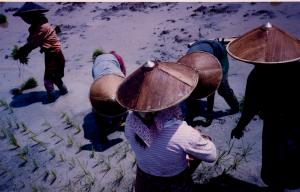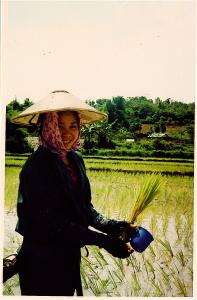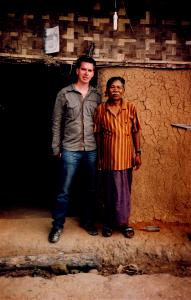I met the "ice maker " in the city of Kengtung in northeastern Shan State Myanmar. He was a 72-year-old Burmese adventurer, retired physics teacher, headmaster, one time glider pilot, part time tour guide, full time gossip dashing ladies' man. The Ice Maker and me after drinking local spirits. He was known as the ice maker since his current occupation consisted of delivering ice via his 30-year-old Honda motorbike to all the shops in Kengtung.
We met, unexpectedly, on the street near his favorite tea shop. I was desperately trying to find someone who could assist me in finding a guide to go trekking. I was also interested in getting a sense of what the current political situation was like in Shan State.
One of the reasons I had to fly over to Kengtung and not take the road was that the Burmese government didn't want nosy tourists wondering around when there was a possibility of fighting. Supposedly, there was an insurgency taking place in the hills with the Shan State army.
Since I arrived I found it hard to communicate. My Burmese language skills were horrendous. They consisted of – Hello, I am full, Goodbye, Where is the bathroom, and this little gem, Go away you crazy idiot – the last of which I had to use only once with a local drunkard who kept insisting I purchase the Burmese propaganda rag – The New Light Of Myanmar.
In Kengtung and the surrounding mountains there is an ethnic stew made up of various hill tribes. You have the Akka, Lahu, Lisu, Shan, Wa, Ann, Palaung, to name a few. Each has a distinct language and custom. Thus Burmese is not the only language you hear on the streets.
I was studying a map of the city, assuming the role of inept tourist, when I had the fortune to meet my unexpected expert on all things Burmese, or as I would soon find out, all things in general. I distinctly remember a hearty laugh from over my shoulder, while I looked at my map in frustration. I turned around to see a short Burmese gentleman with a bushy Colonel Mustard mustache. He shouted over his loud motor bike engine in perfect English and said, "Do you need any help, sir?"
His outfit was interesting. He was equipped with a dubious looking motorcycle helmet, held together with electrical tape. A polo shirt with the word "Rambo" printed over the left breast pocket, and, of course, a brilliant purple Burmese sarong. He introduced himself as the "ice maker". With a name like that maybe he was part of some Burmese hip hop group. Only then did I notice what looked like an old wooden milk crate haphazardly strapped to the back of his bike, with the remains of ice melting away.
He told me to jump on his motorbike. I was a little nervous because it was held together with bailing wire and electrical tape. The electrical tape reminded me of my father, who used to apply it liberally to various appliances in my New Jersey home when I was a child. I wondered if his motorbike would make it down the street, let alone outside the city.
I was also hesitant to go with him since I had only recently arrived in Kengtung from Inle Lake. (I had taken a non traditional route via an internal flight, flew from Taunggi. Most foreigners come over the boarder via Thailand with a two week pass). However, I was desperately hungry and thought: why not take a ride with this guy, what could happen, he seems like he knows his way around. I carefully got on the back of the motorbike, (I am six feet – quite amusing to see a lanky white guy trying to grab the back of a 72-year-old 5'3" Burmese man).

 Shan women off the road to Mong La
Shan women off the road to Mong La
I wanted to try Shan noodles. He told me he knew a family who made the best noodles. They lived in a Shan village about 10 kilometers outside of town. I agreed to go. I asked how much I needed to pay him. He looked at me, laughed and said one liter of fuel for his motorbike. As we left town, we passed through a crumbling century-old gate built by the the Shan, who used to control this part of Burma. I felt as though I were going back in time.
The ice maker liked to sing. He was particularly fond of English and American songs from the fifties. He also had connections; everyone we drove by knew him. We stopped at what appeared to be a toll booth. He drove around the gate, said hello to the attendant, and told him he would pay next time, laughing. The attendant smiled and waved him through.
We were headed into former Wa territory. Wa opium lords used to control this area; they battled the Burmese army for control. The Wa were also involved with a casino. A few years back the Chinese built a massive casino in Mong La; located close to the border with China. Rumor was that it was staffed by transsexuals.

 Shan girl working in the rice paddies
Shan girl working in the rice paddies
It was an amazing motorcycle trip; scenery right out of the pages of National Geographic. We passed terraced rice paddies, groups of women working in the rice paddies, or on their way to work. The ice maker drove slowly by and sang them a song. I think he made up lyrics, which went something like this "Come with me back home, I'll make you dinner and we will have fun."
We went by several Shan villages until we finally found the home of the family he said he knew. The woman was not home; her younger sister and husband had just returned from work. They greeted us. The Shan are hospitable: the woman made us tea, we sat down and relaxed as though we were relatives.
After tea we drove almost all the way to Mong La before we ran out of light. We got our Shan noddles from a roadside restaurant that was on our way back to town near the toll booth we had passed earlier in the day. Again, the ice maker did not pay the toll. The gate attendant waved him through as if this was routine.
The following days we planned expeditions. His enthusiasm for some of these impromptu tours was amazing. He showed me a miniature bamboo bridge which could have doubled for the famous bridge on the River Kwai. We trekked a mountain to visit one of the most traditional hill tribes: the Ann people whose women have teeth stained black from betel nut. We spent hours at local tea shops where we debated the beauty of the Shan women vs the Burmese. One piece of information he gave that I thought fit the West's view of Burma was this: if you go to a tea shop and there are six people drinking tea, three of those patrons will more than likely be government informants listening in on your conversation.

 The Ice Maker and me after
drinking local spirits
The Ice Maker and me after
drinking local spirits
Our last trip out of town was in pursuit of what he described as the best honey in all of Shan State. We visited a Lahu couple at their home. They sold the honey at the famous market in Kengtung. On several occasions we consumed what he liked to call, "local spirits", or Shan Whiskey. Everyone smiled when we drove by – me on the back of his motorbike holding on, buzzed out of my mind on local spirits as he weaved down the road at the top speed of five miles an hour. We somehow never crashed; maybe because my feet dragged on the ground for balance.
I had planed on staying in Kengtung for six days; I stayed twelve. I met the ice maker at a street stall for our final meeting. I planned to leave on the first bus in the morning to Mae Sai, Thailand. We sat down and ordered tea and plata, a Burmese street snack. He told me he was a physics teacher for 30 years, now retired. He spoke of his theory of the earth, how over millions of years it lost its gravitational pull and drifted into the sun. He illustrated the destruction of the planet on a photocopy of my passport.
I asked for his real name so I could send him a postcard. He wrote it down. We shook hands. I wished him good luck; his eyes were a little watery so I departed quickly. I still have the copy of my passport, stained with tea. I can make out his name below his drawing of the solar system.